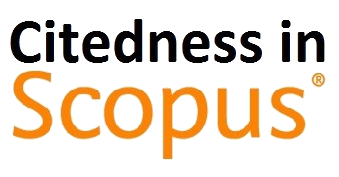Data mining techniques are being used to map the number of foreign guests at Indonesian star hotels
(1) Universitas Battuta, Medan, North Sumatra, Indonesia
(2) STAI An-Nadwah Kuala Tungkal, Jambi, Indonesia
(*) Corresponding Author
Abstract
Statistics on foreign tourist arrivals show an upward trend in recent years. This is beneficial because foreign exchange in the tourism sector is generated by spending by foreign tourists visiting Indonesia. Mapping the number of tourists who visit Indonesia is necessary to determine the extent of a region's natural potential. The number of foreign guests at Indonesia's star hotels is one indicator that can be used. The goal of this study is to use data mining techniques to visualize the mapping pattern of the number of foreign guests at five-star hotels in order to obtain important information. The Central Statistics Agency (abbreviated BPS) provided the data for the number of foreign guests at five-star hotels in 2017-2019. Clustering with the k-medoids technique is the data mining method employed. The Davies-bouldin index (DBI) operator is used to calculate the number of clusters. The number of good clusters was 3 (k=3), with cluster 0 (low) = 20 provinces, cluster 1 (normal) = 23, and cluster 2 (high) = 1 province, and a DBI value of 0.215 (k=3). According to the study's findings, the province of Bali is one of the areas with the greatest potential for foreign tourist visits (high cluster). Meanwhile, there are 20 provinces with a low number of foreign visitor visits, so this can be used to assess how to increase the number of foreign visitor visits to the province.
Full Text:
PDFReferences
A. A. Rahma, “Potensi Sumber Daya Alam dalam Mengembangkan Sektor Pariwisata di Indonesia,” Jurnal Nasional Pariwisata, vol. 12, no. 1, pp. 1–8, 2020.
M. Febriani Jayadi and I. B. Suryawan, “Strategi Pengembangan Potensi Pariwisata di Pantai Blimbingsari Kabupaten Banyuwangi,” Jurnal Destinasi Pariwisata, vol. 8, no. 1, p. 10, 2020, doi: 10.24843/jdepar.2020.v08.i01.p02.
T. I. dan P. Direktorat Statistik Keuangan, “Tingkat Penghunian Kamar Hotel 2020,” Badan Pusat Statistik, 2020.
Z. R. S. Elsi et al., “Utilization of Data Mining Techniques in National Food Security during the Covid-19 Pandemic in Indonesia,” Journal of Physics: Conference Series, vol. 1594, no. 1, 2020, doi: 10.1088/1742-6596/1594/1/012007.
M. Widyastuti, A. G. Fepdiani Simanjuntak, D. Hartama, A. P. Windarto, and A. Wanto, “Classification Model C.45 on Determining the Quality of Custumer Service in Bank BTN Pematangsiantar Branch,” Journal of Physics: Conference Series, vol. 1255, no. 1, pp. 1–6, 2019, doi: 10.1088/1742-6596/1255/1/012002.
F. Rahman, I. I. Ridho, M. Muflih, S. Pratama, M. R. Raharjo, and A. P. Windarto, “Application of Data Mining Technique using K-Medoids in the case of Export of Crude Petroleum Materials to the Destination Country,” IOP Conference Series: Materials Science and Engineering, vol. 835, no. 1, 2020, doi: 10.1088/1757-899X/835/1/012058.
S. Sundari, Karmila, M. N. Fadli, D. Hartama, A. P. Windarto, and
A. Wanto, “Decision Support System on Selection of Lecturer Research Grant Proposals using Preferences Selection Index,” Journal of Physics: Conference Series, vol. 1255, no. 1, pp. 1–8, 2019, doi: 10.1088/1742-6596/1255/1/012006.
A. Waluyo, H. Jatnika, M. R. S. Permatasari, T. Tuslaela, I. Purnamasari, and A. P. Windarto, “Data Mining Optimization uses C4.5 Classification and Particle Swarm Optimization (PSO) in the location selection of Student Boardinghouses,” IOP Conference Series: Materials Science and Engineering, vol. 874, no. 1, pp. 1–9, 2020, doi: 10.1088/1757-899X/874/1/012024.
W. Katrina, H. J. Damanik, F. Parhusip, D. Hartama, A. P. Windarto, and A. Wanto, “C.45 Classification Rules Model for Determining Students Level of Understanding of the Subject,” Journal of Physics: Conference Series, vol. 1255, no. 1, 2019, doi: 10.1088/1742-6596/1255/1/012005.
S. Dsouza, J. D. Dsouza, and T. Vanitha, “Analysis of Algorithms Data K-Means and K-Medoids,” International Journal of Latest Trends in Engineering and Technology, pp. 370–373, 2017.
I. C. Dewi, B. Y. Gautama, and P. A. Mertasana, “Analysis of Clustering for Grouping of Productive Industry by K-Medoid Method,” International Journal of Engineering and Emerging Technology, vol. 2, no. 1, p. 26, 2017, doi: 10.24843/ijeet.2017.v02.i01.p06.
A. K. Singh, S. Mittal, P. Malhotra, and Y. V. Srivastava, “Clustering Evaluation by Davies-Bouldin Index(DBI) in Cereal data using K-Means,” Proceedings of the 4th International Conference on Computing Methodologies and Communication, ICCMC 2020, no. Iccmc, pp. 306–310, 2020, doi: 10.1109/ICCMC48092.2020.ICCMC-00057.
J. Xiao, J. Lu, and X. Li, “Davies Bouldin Index based hierarchical initialization K-means,” Intelligent Data Analysis, vol. 21, no. 6, pp. 1327–1338, 2017, doi: 10.3233/IDA-163129.
N. Azis, Y. Ali, R. Subekti, P. Junianto, and L. Diner, “Mapping study using the unsupervised learning clustering approach,” IOP Conference Series: Materials Science and Engineering PAPER, 2021, doi: 10.1088/1757-899X/1088/1/012005.
DOI: https://doi.org/10.30645/ijistech.v5i2.137
Refbacks
- There are currently no refbacks.
Jumlah Kunjungan:
Published Papers Indexed/Abstracted By:












